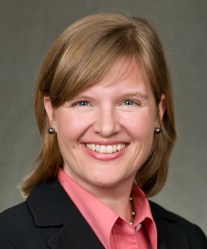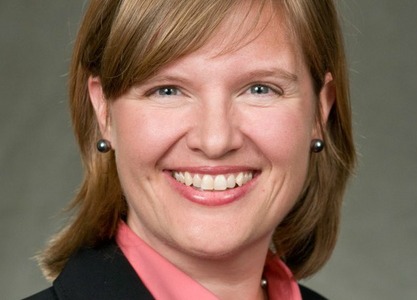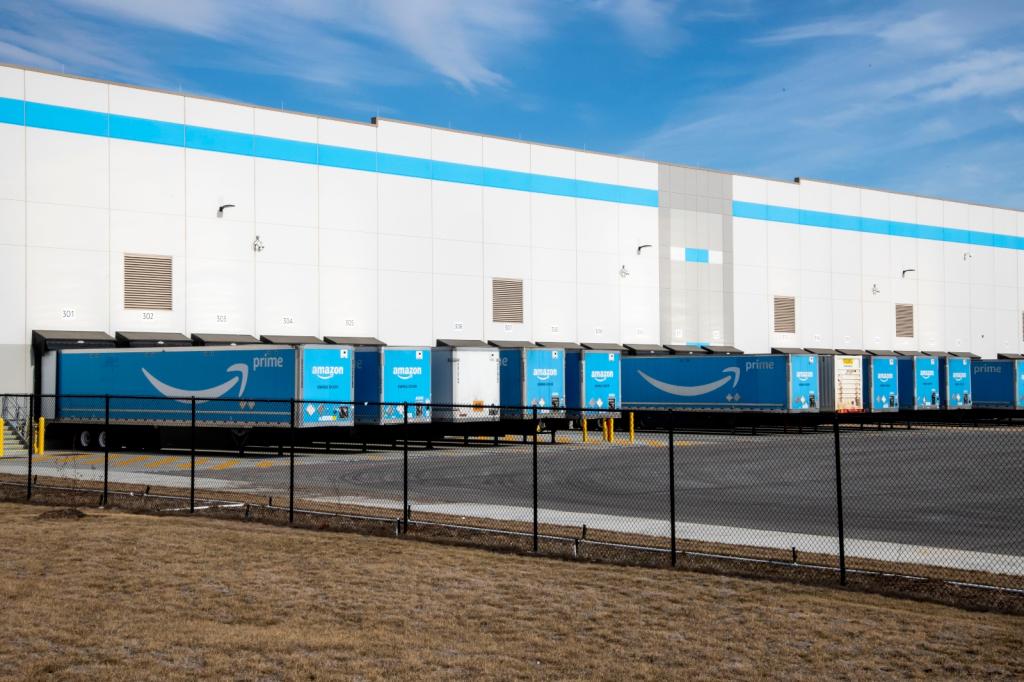If San Francisco were a popular band, it’d be Radiohead: Overachieving, arch, holier-than-thou — and yet undeniably well-loved and two steps ahead of everyone else. Plastic bag ban? “Duh — and expanding.” Mandatory composting and recycling? “Everything in its right place — and let’s shoot for zero waste by 2020.” A solar financing program? “Definitely. And let’s model it after Groupon, while we’re at it, to catch the zeitgeist.”
But even a city on the cutting edge has its share of difficult realities to face. The city has the second-most expensive housing market in the U.S. and middle-class families are being priced out. California could see a 16-inch sea-level rise by mid-century and 55 inches by 2100, according to one estimate [PDF]. Surrounded by water on three sides, the city is particularly vulnerable.

Melanie Nutter.
Still, San Francisco Department of the Environment Director Melanie Nutter is optimistic. “Cities are so well-poised to take action and make a collective impact,” she says. “That’s one of the reasons I love working on the local level. You can really see that movement and that change.”
Nutter has tried the alternative: She was working for then-Speaker Nancy Pelosi when national climate bills seemed attainable. “It takes so much to try to move policy at the federal level,” she says. “Waxman-Markey was very disappointing to see fall apart.”
I talked to Nutter for Knope and change, our series on the women working hard to green our cities. Here’s an edited version of our conversation:
Q. I recently saw a map of San Francisco looking at possible sea-level rise scenarios. It wasn’t pretty. What are you planning for and how are you planning for it?
A. This is very much on our minds in light of Sandy and the extreme weather events that we are starting to see. Just in the past two weeks, we’ve had torrential downpours in San Francisco. Rain is common this time of year, but there’s been a number of atmospheric conditions that created a [Pineapple Express], which was basically a complete dumping. There are pictures of places in San Francisco where it’s up to people’s knees on certain streets where the storm drains got flooded from what we thought was going to be a simple rainshower. We are reminded again and again how vulnerable we are.
Many different city agencies in San Francisco have their own adaptation programs or projects where they’ve looked at how changes in sea-level rise or climate impacts could affect their agencies. The public utilities commission has been looking at how snowpack is going to affect the water supply as well as how sea-level rise will affect storm drains. This month, the Department of the Environment is launching an effort to bring all of those city agencies together. We know we need a grander, more unified, collaborated effort.
Q. Can you act fast enough? COP18 looks to be another letdown when it comes to international climate change efforts. On the federal level, things aren’t looking very hopeful either.
A. The good news is that San Francisco has already made great progress on reducing our carbon emissions locally. [Editor’s note: San Francisco is working on a review of how much they’ve been able to cut emissions. There’s been debate over the numbers in the past.] We’ve done a lot of great work locally and I think we’re on a good track to reduce emissions even more. That being said, carbon emissions do not obey city boundaries.
There is only so much you can do locally, but I’m hopeful about cities in general. Cities account for 75 percent of greenhouse gas emissions worldwide and about 80 percent of the energy use worldwide. If cities do act, and we’re not just all recreating the wheel and are instead sharing best practices and taking action and being nimble, cities can really accelerate progress.
Q. San Francisco has seen a 10 percent decline in the number of middle-class households. New York is the only U.S. city with a less-affordable housing market. Is your department involved in slowing this in any way?
A. To be honest, housing policy is not something within our purview. There is a lot going on in the city to help increase access to affordable housing in San Francisco. [We] see a lot of families who end up leaving the city and county of San Francisco due to affordability. It’s one thing to move here in your 20s and live in an apartment with lots of roommates. It’s another thing to try to raise a family where you have a lot of additional costs. There are certain populations that are disproportionately affected by issues of affordability. One of the things we really try to focus on is, even if you’re not as concerned about greenhouse gas emissions, we have a lot of programs that can help your family save money on their energy bill. There are ways that we can ensure that [sustainability] isn’t only about environmental protection and some of these bigger goals but that it’s also about individual lives and how people can benefit.
Q. Your green building labels program is praised for boosting property values.
A. It increases the property values but it doesn’t trigger an assessment, so it’s not going to increase people’s property taxes. And when you think about a green, efficient building, they’re cheaper [to] operate. There’s a direct connection between greening and bringing costs down. The question is “Are those savings passed down from a property manager to tenants in a particular apartment building or commercial building?” That’s of course what we would like to see.
Q. San Francisco has some of the highest parking prices in the nation. One of your department’s goals is to get people out of their cars. Are high parking prices a way to encourage that, or just a budget issue?
A. That’s a budget issue. It’s been a way to generate more revenue for the transportation agency to increase transit. One of the programs we’re supporting is the SF Park Program which is basically congestion pricing at the meter level. MTA is able to see in real time what streets are congested and adjust parking rates based on congestion. That’s very helpful because it decreases idling and circling in very congested areas and it’s a disincentive to bring your car into certain congestion areas. It decreases greenhouse gas emissions and it also helps people think about alternatives to bringing their car into the city.
Q. San Francisco is getting a reputation for parklets, in which a parallel parking space is turned into a tiny park.
A. They’ve been an essential component to greening communities and bringing community members back out into neighborhoods in certain areas where there wasn’t a lot of street traffic. There are certain streets that have greatly transformed. … [On Valencia Street,] you can feel the palpable difference. There’s a lot more thriving businesses, a lot more activity. It’s basically a thriving merchant corridor. It’s something we passively support, but we don’t implement it. The planning department is in charge of issuing parklet permits. But we do our own parking day outside the Department of the Environment. Once a year, we take over the parking spaces in front of our building and do outreach and education as part of raising awareness for the movement.
Q. You’ve topped many a greenest city list. Who are your closest competitors?
A. We like to say we’re collaborators. Competition would mean that we’re all trying to [individually] win. We all want to collectively win. Certainly some of the cities we work with a lot and who are on the cutting edge include Vancouver, Seattle, New York, Chicago. Melbourne is doing amazing work. Sydney, Tokyo — there are so many incredible cities around the world that are doing amazing things. Portland.
Q. You might keep an eye out for Portland. I hear they have a competitive streak.
A. [Laughs] Yeah, I’d say those are the cities that are our “closest allies.”
Q. Where is San Francisco headed next in terms of sustainability?
A. I think the future of San Francisco is really going to be about how all of our individual siloed sustainability initiatives will get connected and integrated. We are working to be one of the first VERGE cities which is a term that was coined by Green Biz. It’s a smart cities concept where you think about how technology can really enable the connection between the building sector, the transportation sector, and the energy sector to have not only a sustainable city but a smart city.
That’s one vision of where we are headed. The other is a future where we don’t have a green job and we don’t have a green building. Sustainability will just be the norm — integrated into all that we do.
Q. Business as usual.
A. Exactly. Sustainability will be business as usual.





